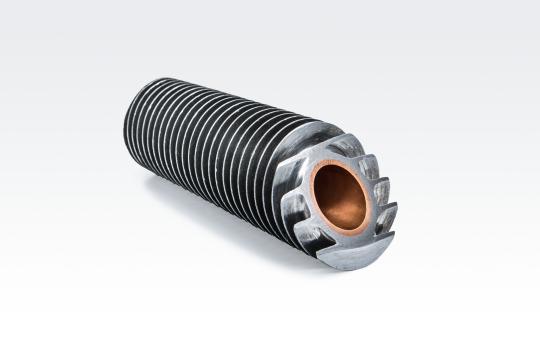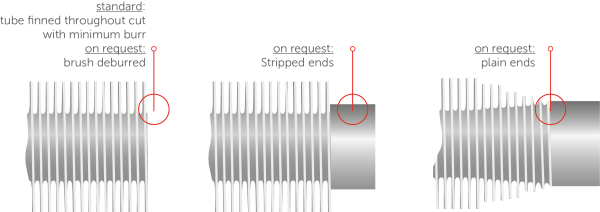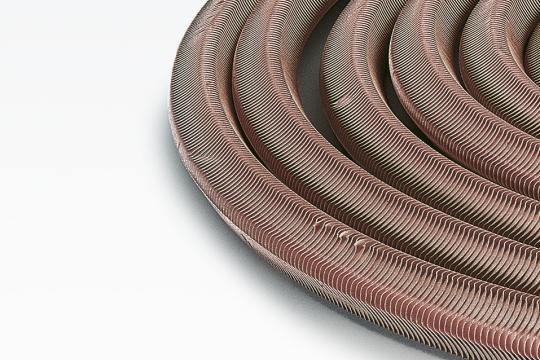Data sheet
Wieland GEWA-H Finned Tubes
High finned tubes for significantly enlarged outside surface

Wieland GEWA-H are high finned tubes and have a much greater outer surface than smooth tubes. This allows particularly compact designs. They are made of copper, copper alloys or aluminum alloys and resist very high mechanical and thermal stress.
GEWA-HB versions have a core tube made of a different material than the outer finned tube.
| Tube number | Alloy* | Tube type** | Fin pitch [fins/inch] | Outside diameter [mm] | Fin height [mm] | Inside diameter [mm] | Outside surface area [m2/m] | Approx. weight [kg/m] |
| H-0710.19152-00 | K21 | H | 7 | 38.88 | 9.90 | 16.04 | 0.54 | 2.17 |
| H-0710.22179-00 | K21 | H | 7 | 42.29 | 9.83 | 19.05 | 0.60 | 2.75 |
| H-0710.26215-00 | K21 | H | 7 | 46.85 | 10.14 | 22.27 | 0.70 | 3.27 |
| H-0809.19183-00 | K21 | H | 8 | 37.56 | 8.93 | 16.04 | 0.54 | 2.14 |
| H-0810.25170-00 | K21 | H | 8 | 46.56 | 10.39 | 22.38 | 0.79 | 2.95 |
| H-0710.26192-00 | L10 | H | 7 | 46.45 | 10.14 | 22.33 | 0.69 | 3.06 |
| H-0810.25170-00 | L10 | H | 8 | 46.56 | 10.39 | 22.38 | 0.79 | 2.95 |
| H-0904.22220-00 | A22 | H | 9 | 31.40 | 4.45 | 18.10 | 0.32 | 0.64 |
| H-0909.20200-00 | A22 | H | 9 | 39.00 | 9.25 | 16.50 | 0.66 | 0.75 |
| H-0906.35270-00 | A22 | H | 9 | 47.65 | 6.00 | 30.25 | 0.65 | 1.20 |
| H-0908.27200-00 | A22 | H | 9 | 43.00 | 8.00 | 23.00 | 0.69 | 0.96 |
| HB-0710.26155-00 | A22 | HB | 7 | 46.70 | 10.30 | 23.00 | 0.70 | 0.85 |
| HB-0812.23207-00 | A22 | HB | 8 | 46.40 | 11.70 | 18.85 | 0.84 | 0.96 |
| HB-1108.11060-00 | A05 | HB | 11 | 28.00 | 8.40 | 10.00 | 0.46 | 0.54 |
* K = copper | L = copper-nickel | A = aluminum
** H = high finned | HB = high finned + core tube

Explanation based on the example of tube no. H-0710.19152-00
| H- | 07 | 10. | 19 | 152 | -00 |
| Tube type | Fins/inch | Fin height [mm] | Core-tube diameter [mm] | Wall thickness [1/100 mm] | Inner structure (00 = plain) |
| Length [mm] | Length tolerances |
| < 2,000 | + 2 mm |
| 2,000 - 8,000 | + 1 ‰ (max 5 mm) |
| > 8,000 | 0.7 ‰ |

GEWA-HB | Bimetallic tube
Carbon steel, stainless steel, titanium, copper and copper alloys can be used as materials for the core tube. Materials susceptible to stress corrosion cracking are not recommended.
- Heating (gas-fired boilers, flue gas condensers)
- Machinery and plant technology (oil coolers, mine coolers, air coolers for diesel engines)
- Power plants (air coolers, cooling towers)
- Nuclear engineering
Production Process
The fins are obtained by roll forming the outer surface of a plain tube. This process results in an increase of strength in the finned sections, whereas the plain ends remain soft.
High finned tubes require materials which can be easily cold worked such as aluminum and copper. Aluminum and aluminum alloys allow up to 15 mm fin height, copper up to 10 mm. Soft annealing of the finned tubes is necessary if they must be suitable for bending and coiling.
If required, GEWA-HB bimetallic tubes have a core tube on the inside made of a different material. In that case, the outer tube is rolled onto the core tube so as to provide for a firm bond and good thermal contact between the tubes.
The maximum operating temperature is defined in each case because of the difference in thermal expansion between the core tube and the finned tube. At operating temperatures above + 250 °C a reduction in heat transfer is possible.
In further processing GEWA-H and GEWA-HB finned tubes are expanded, welded or soldered into tube plates or can be sealed with O-rings.
| Wieland Materials | EN-Symbol | Material No. | UNS-No. |
| A05 | Al99.5 | EN AW 1050A | - |
| A22 | AW-AlMgSi | EN AW 6060 | - |
| K21 | Cu-DHP | CW024A | C12200 |
| L10 | CuNi10Fe1Mn | CW352H | C70600 |
The primary material complies with the requirements of DIN EN 12451, AD-2000 Merkblatt W6/2 and on request with ASTM B111 or ASTM B75. For aluminum individually standards agreed with the customer can be applied.
Quality Assurance
To ensure consistent product quality, Wieland-Werke AG has a sophisticated quality control system according to DIN EN ISO
9001:2015 which has been verified and certified by an independent certification company. Our test laboratories in the Central Laboratory and Development Services have been accredited to DIN EN ISO/IEC 17025:2018 and DIN EN ISO 9001 as test and certification laboratories.
Technical service
Our Technical Marketing experts are available at any time as contact partners to work together with your experts from the
very early product planning stages in order to obtain optimum results for the manufacturing stage and for your application.
The only way to find the best, most cost-effective solution is by means of comprehensive technical consultation based on
computerised thermal engineering rating.



